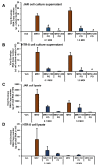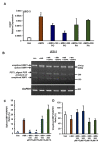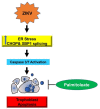Palmitoleate Protects against Zika Virus-Induced Placental Trophoblast Apoptosis
- PMID: 34200091
- PMCID: PMC8226770
- DOI: 10.3390/biomedicines9060643
Palmitoleate Protects against Zika Virus-Induced Placental Trophoblast Apoptosis
Abstract
Zika virus (ZIKV) infection in pregnancy is associated with the development of microcephaly, intrauterine growth restriction, and ocular damage in the fetus. ZIKV infection of the placenta plays a crucial role in the vertical transmission from the maternal circulation to the fetus. Our previous study suggested that ZIKV induces endoplasmic reticulum (ER) stress and apoptosis of placental trophoblasts. Here, we showed that palmitoleate, an omega-7 monounsaturated fatty acid, prevents ZIKV-induced ER stress and apoptosis in placental trophoblasts. Human trophoblast cell lines (JEG-3 and JAR) and normal immortalized trophoblasts (HTR-8) were used. We observed that ZIKV infection of the trophoblasts resulted in apoptosis and treatment of palmitoleate to ZIKV-infected cells significantly prevented apoptosis. However, palmitate (saturated fatty acid) did not offer protection from ZIKV-induced ER stress and apoptosis. We also observed that the Zika viral RNA copies were decreased, and the cell viability improved in ZIKV-infected cells treated with palmitoleate as compared to the infected cells without palmitoleate treatment. Further, palmitoleate was shown to protect against ZIKV-induced upregulation of ER stress markers, C/EBP homologous protein and X-box binding protein-1 splicing in placental trophoblasts. In conclusion, our studies suggest that palmitoleate protects placental trophoblasts against ZIKV-induced ER stress and apoptosis.
Keywords: Zika virus; apoptosis; endoplasmic reticulum stress; monounsaturated fatty acids; placenta; trophoblast; viral replication.
Conflict of interest statement
The authors declare no conflict of interest.
Figures









Similar articles
-
Novel Therapeutic Nutrients Molecules That Protect against Zika Virus Infection with a Special Note on Palmitoleate.Nutrients. 2022 Dec 27;15(1):124. doi: 10.3390/nu15010124. Nutrients. 2022. PMID: 36615782 Free PMC article. Review.
-
Zika virus infection induces endoplasmic reticulum stress and apoptosis in placental trophoblasts.Cell Death Discov. 2021 Jan 26;7(1):24. doi: 10.1038/s41420-020-00379-8. Cell Death Discov. 2021. PMID: 33500388 Free PMC article.
-
HSV-2 enhances ZIKV infection of the placenta and induces apoptosis in first-trimester trophoblast cells.Am J Reprod Immunol. 2016 Nov;76(5):348-357. doi: 10.1111/aji.12578. Epub 2016 Sep 10. Am J Reprod Immunol. 2016. PMID: 27613665
-
Saturated free fatty acids induce placental trophoblast lipoapoptosis.PLoS One. 2021 Apr 22;16(4):e0249907. doi: 10.1371/journal.pone.0249907. eCollection 2021. PLoS One. 2021. PMID: 33886600 Free PMC article.
-
Crosstalk between RNA Metabolism and Cellular Stress Responses during Zika Virus Replication.Pathogens. 2020 Feb 25;9(3):158. doi: 10.3390/pathogens9030158. Pathogens. 2020. PMID: 32106582 Free PMC article. Review.
Cited by
-
The regulated cell death at the maternal-fetal interface: beneficial or detrimental?Cell Death Discov. 2024 Feb 26;10(1):100. doi: 10.1038/s41420-024-01867-x. Cell Death Discov. 2024. PMID: 38409106 Free PMC article. Review.
-
Palmitate induces integrated stress response and lipoapoptosis in trophoblasts.Cell Death Dis. 2024 Jan 11;15(1):31. doi: 10.1038/s41419-023-06415-6. Cell Death Dis. 2024. PMID: 38212315 Free PMC article.
-
Novel Therapeutic Nutrients Molecules That Protect against Zika Virus Infection with a Special Note on Palmitoleate.Nutrients. 2022 Dec 27;15(1):124. doi: 10.3390/nu15010124. Nutrients. 2022. PMID: 36615782 Free PMC article. Review.
References
-
- Moore C.A., Staples J.E., Dobyns W.B., Pessoa A., Ventura C.V., Da Fonseca E.B., Ribeiro E.M., Ventura L.O., Neto N.N., Arena J.F., et al. Characterizing the Pattern of Anomalies in Congenital Zika Syndrome for Pediatric Clinicians. JAMA Pediatr. 2017;171:288–295. doi: 10.1001/jamapediatrics.2016.3982. - DOI - PMC - PubMed
-
- Rosário M.S.D., De Siqueira I.C., Rodrigues S.G., Martins L.C., Vasilakis N., Novaes M.A.C., Alcantara L.C.J., Farias D.S., Jesus P.A., Ko A.I., et al. Guillain–Barré Syndrome After Zika Virus Infection in Brazil. Am. J. Trop. Med. Hyg. 2016;95:1157–1160. doi: 10.4269/ajtmh.16-0306. - DOI - PMC - PubMed
Grants and funding
LinkOut - more resources
Full Text Sources
Research Materials

